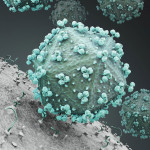Taking a statin can help stabilize coronary artery plaque, reducing the risk that it will rupture and cause a heart attack or stroke, according to the latest findings from the REPRIEVE trial, published in JAMA Cardiology.
As people with HIV live longer thanks to effective antiretroviral treatment, cardiovascular disease (CVD) has become a leading cause of illness and death. Studies suggest that HIV-positive people have about a twofold higher risk for CVD compared with their HIV-negative peers, and people with HIV tend to experience cardiovascular complications at younger ages.
Results from the large REPRIEVE trial, presented at the 2023 International AIDS Society Conference on HIV Science and published in The New England Journal of Medicine, showed that middle-aged HIV-positive people with low to moderate CVD risk scores who took daily pitavastatin (Livalo) lowered their risk for heart attacks, strokes and other major cardiovascular events by 35%.
Based on these findings, federal treatment guidelines were updated in February 2024 to recommend statins for HIV-positive people ages 40 to 75 with low to intermediate 10-year CVD risk. People in this age group with high CVD risk and those who have already had a heart attack or related events have long been advised to take statins regardless of their HIV status.
The main effect of statins is lowering low-density lipoprotein (LDL) cholesterol, which contributes to the buildup of plaque in arteries, known as atherosclerosis. Unstable plaque can break off, causing clots that block arteries supplying the heart, leading to heart attack, or lodge in small blood vessels in the brain, leading to stroke. But statins also have secondary effects, including reduced inflammation. REPRIEVE showed that the benefits of pitavastatin were much greater than predicted by lowering LDL alone.
A REPRIEVE substudy found that pitavastatin reduced the volume of noncalcified plaque in arteries. Steven Grinspoon, MD, of Massachusetts General Hospital, and colleagues performed a post hoc analysis of the data to shed more light on proteins and gene pathways associated with plaque changes in people with HIV.
This analysis included 558 REPRIEVE participants. About 80% were men, and the mean age was 51 years. At baseline and after two years of follow-up, they underwent coronary computed tomography angiography scans, proteonomic analysis of 255 immune, inflammatory, cardiovascular and cardiometabolic proteins, and transcriptomic analysis of relevant gene expression.
People randomly assigned to take pitavastatin had higher levels of procollagen C-endopeptidase enhancer 1 (PCOLCE), an enzyme that controls deposition of collagen—a component of plaque that helps determine its stability. Changes in PCOLCE levels were associated with a reduction in noncalcified plaque volume and altered composition, such as reduced lipid content, suggesting plaque stabilization. These changes were independent of changes in LDL cholesterol levels.
Statin use was also associated with smaller changes in several other proteins. Notably, there was a decrease in MBL2, a lectin involved in complement activation and inflammation. What’s more, transcriptomic analysis showed that pitavastatin users had enhanced collagen gene expression and more active collagen synthesis pathways.
“Results of this secondary analysis of the REPRIEVE randomized clinical trial suggest that PCOLCE may be associated with the atherosclerotic plaque stabilization effects of statins by promoting collagen deposition in the extracellular matrix transforming vulnerable plaque phenotypes to more stable coronary lesions,” the study authors concluded.
These findings are promising because more stable artery plaque is less likely to rupture and block blood flow.
“[W]e identified a novel pathway that may be associated with the protective effects of statin therapy on coronary plaque,” the researchers wrote. “By increasing the abundance of the rate-limiting enzyme of collagen deposition, PCOLCE may play a role in the atherosclerotic plaque stabilization effects of statins by transforming lipid-rich components of noncalcified plaque to more stable fibrous and calcified components. Further studies are now needed to assess potential targeting of collagen pathways for reduction of vulnerable coronary plaque phenotypes.”
Click here to learn more about HIV and heart health.







Comments
Comments